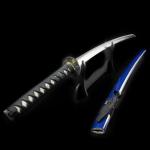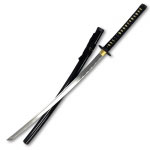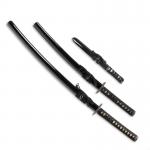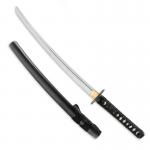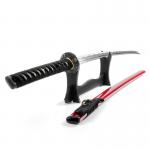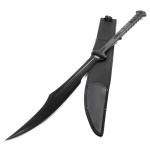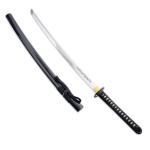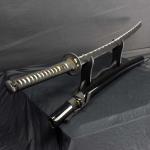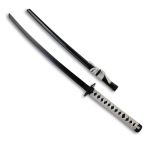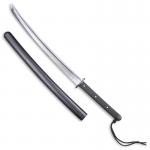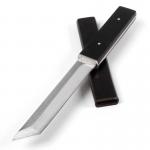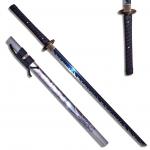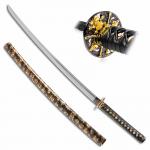Katana Buying Guide: What is Important When Buying a Katana Sword
May 13th, 2025
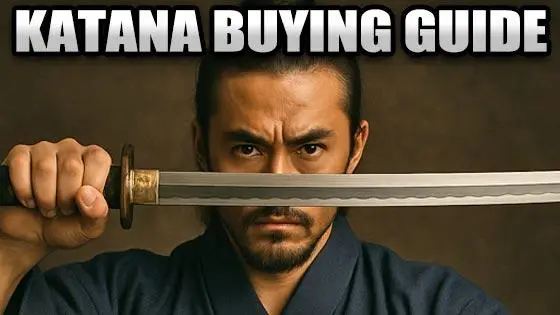
If you're thinking about picking up a katana, you're in good company. These iconic blades are more than just weapons - they're symbols of craftsmanship, tradition, and power. Whether you're buying your first samurai sword or you're just adding to your collection, it can be tough to know what actually matters when you're shopping for a katana.
The truth is, not all katana swords are created equal. Some are purely decorative, others are forged with real steel and built to slice. In this guide, we'll break down what makes a katana special, what you should be looking for, and how to pick a blade that won't disappoint.
A katana is a type of Japanese sword traditionally used by samurai. It's probably the most recognizable style of Japanese sword in the world. Long, slightly curved, and single-edged, a katana usually has a circular or squared guard (called a tsuba) and a long grip to accommodate two hands.
The word "katana" literally means "sword" in Japanese, but it specifically refers to the curved blade that became synonymous with samurai culture. It's not just a cutting tool - it's an object of deep respect and symbolism in Japanese history.
The katana stands out for a few reasons:
Compared to other swords, katana swords offer a unique blend of function and form that just looks (and feels) powerful.
That gentle curve isn't just for looks. The curvature of a katana helps with something called drawing and cutting. The blade slides out of the scabbard and into action smoothly, making it faster to react in battle.
Also, the curve improves cutting efficiency. When you swing a curved blade, it makes better contact with the target, leading to smoother, cleaner cuts. Straight blades often chop, but the katana slices.
The curve also helps reduce shock when you strike a target, making it easier on your wrists and arms.
Today's katana swords are still often made with techniques inspired by traditional swordsmithing. A good katana is forged from high-carbon steel, heated, hammered, and folded to eliminate impurities and improve strength.
The blade is then differentially hardened - the spine stays softer for flexibility, while the edge is hardened for a razor-sharp finish. This contrast in hardness is part of what gives a katana its distinctive edge.
Finally, the blade is polished and assembled with a tsuba (guard), tsuka (handle), and saya (scabbard). Even with modern tools and techniques, a high-quality samurai sword still requires a lot of handwork and care.
The hamon is the wavy line you often see running along the blade. It's not just decoration - it's a visual result of the differential hardening process.
The hamon shows where the blade was hardened and where it was left softer. A real hamon will have some variation and detail to it, while fake ones (on cheap display swords) are often etched or acid-washed to imitate the look.
On a well-made katana sword, the hamon is a sign of quality and craftsmanship.
Even modern katana swords require a little TLC. Here's the basic rundown:
Basic maintenance goes a long way in keeping your samurai sword looking sharp - literally.
The tang is the part of the blade that extends into the handle. A full tang katana means the blade runs all the way through the handle, which is ideal for strength and durability.
Many display swords have rat-tail tangs (thin rods welded to the blade), which are not suitable for cutting or real use.
You can't always see the tang without taking the sword apart, but most reputable sellers will specify if it's full tang. If they don't mention it - it probably isn't.
Here's what to keep an eye out for when shopping:
You don't have to spend a fortune, but you do want a katana that's built to perform, not just hang on a wall.
If you're just starting out, don't worry about going full custom or blowing your budget. A good beginner katana should be:
Stay away from stainless steel swords unless you're buying a display piece. Stainless doesn't hold up well to impact. A real, functional katana sword will have a bit of weight, a good grip, and a blade that means business.
Traditionally, when displayed on a stand (called a katana kake), the katana is placed with the edge up and the curve facing downward. This reflects how it would be worn by a samurai: blade-up, ready to draw.
The handle should be on the left side, which is considered a peaceful posture (since it would take extra effort to draw the sword from that position).
Of course, if you're just trying to show off how cool your Japanese sword looks, feel free to get creative. Just don't lean it in a corner where someone might knock it over.
While the katana is the most famous Japanese sword, it's part of a broader family:
Each type serves a purpose, but the katana remains the centerpiece of any samurai sword collection.
There's a lot of mythology around the katana, and not all of it is true:
Knowing what's real and what's hype will save you money (and disappointment).
If this is your first Japanese sword, steer clear of these pitfalls:
Take your time and do your homework. A little knowledge goes a long way.
Once you've got your sword, it's time to gear up:
Accessorizing not only helps preserve your sword - it shows you respect it.
Buying a katana is part art, part science. Yes, it's a weapon. Yes, it's a collector's item. But it's also a personal choice. Whether you're planning to slice some tatami mats, practice martial arts, or just hang something badass on your wall, there's a samurai sword out there with your name on it.
The good news is that you don't need to fly to Japan or spend thousands to get a great sword. There are incredible hand-forged katana swords available today that combine tradition, beauty, and serious cutting power.
Just remember: Look for full tang construction, high-carbon steel, solid craftsmanship, and a reputable source. You'll be slicing with style in no time.
Ready to find your perfect blade? Browse our collection of premium-quality katana swords and let your inner samurai loose.
What Is a Katana?
A katana is a type of Japanese sword traditionally used by samurai. It's probably the most recognizable style of Japanese sword in the world. Long, slightly curved, and single-edged, a katana usually has a circular or squared guard (called a tsuba) and a long grip to accommodate two hands.
The word "katana" literally means "sword" in Japanese, but it specifically refers to the curved blade that became synonymous with samurai culture. It's not just a cutting tool - it's an object of deep respect and symbolism in Japanese history.
What Makes a Katana Different From Other Swords?
The katana stands out for a few reasons:
- Curved blade: Unlike European swords that are typically straight, the katana's curve helps with slicing rather than just stabbing or slashing.
- Single edge: Most katana have a razor-sharp cutting edge on one side, making them extremely efficient for clean cuts.
- Construction: Traditional and modern katana swords are often hand-forged and polished, with attention to balance and aesthetics.
- Cultural significance: Samurai swords aren't just weapons - they're status symbols and spiritual objects.
Compared to other swords, katana swords offer a unique blend of function and form that just looks (and feels) powerful.
Why Is a Katana Curved?
That gentle curve isn't just for looks. The curvature of a katana helps with something called drawing and cutting. The blade slides out of the scabbard and into action smoothly, making it faster to react in battle.
Also, the curve improves cutting efficiency. When you swing a curved blade, it makes better contact with the target, leading to smoother, cleaner cuts. Straight blades often chop, but the katana slices.
The curve also helps reduce shock when you strike a target, making it easier on your wrists and arms.
How Is a Katana Made?
Today's katana swords are still often made with techniques inspired by traditional swordsmithing. A good katana is forged from high-carbon steel, heated, hammered, and folded to eliminate impurities and improve strength.
The blade is then differentially hardened - the spine stays softer for flexibility, while the edge is hardened for a razor-sharp finish. This contrast in hardness is part of what gives a katana its distinctive edge.
Finally, the blade is polished and assembled with a tsuba (guard), tsuka (handle), and saya (scabbard). Even with modern tools and techniques, a high-quality samurai sword still requires a lot of handwork and care.
What Is the Hamon on a Katana?
The hamon is the wavy line you often see running along the blade. It's not just decoration - it's a visual result of the differential hardening process.
The hamon shows where the blade was hardened and where it was left softer. A real hamon will have some variation and detail to it, while fake ones (on cheap display swords) are often etched or acid-washed to imitate the look.
On a well-made katana sword, the hamon is a sign of quality and craftsmanship.
How Do You Maintain a Katana?
Even modern katana swords require a little TLC. Here's the basic rundown:
- Keep it dry: Moisture can lead to rust, even on stainless steel or coated blades.
- Oil the blade: Use a light sword oil every few weeks to protect the metal.
- Avoid touching the blade: Your fingerprints contain oils and acids that can cause corrosion.
- Store it properly: Keep the katana in its scabbard in a dry environment, ideally laid horizontally or blade-up if displayed vertically.
Basic maintenance goes a long way in keeping your samurai sword looking sharp - literally.
What Is the Tang of a Katana? How Can You Tell How Long the Tang Is?
The tang is the part of the blade that extends into the handle. A full tang katana means the blade runs all the way through the handle, which is ideal for strength and durability.
Many display swords have rat-tail tangs (thin rods welded to the blade), which are not suitable for cutting or real use.
You can't always see the tang without taking the sword apart, but most reputable sellers will specify if it's full tang. If they don't mention it - it probably isn't.
What Are the Most Important Things to Look for When Buying a Katana?
Here's what to keep an eye out for when shopping:
- Full tang construction
- Carbon steel blade (like 1045, 1060, or 1095 steel) - Other popular steels include tool steels, spring steels, and manganese steels.
- Real hamon line (not etched)
- Functional, hand-forged blade (not cast or stamped)
- Secure fittings (guard, handle, and scabbard should feel tight and solid)
- Proper weight and balance
- Reputation of the seller
You don't have to spend a fortune, but you do want a katana that's built to perform, not just hang on a wall.
What Is the Best Katana for Beginners?
If you're just starting out, don't worry about going full custom or blowing your budget. A good beginner katana should be:
- Affordable but still functional
- Made from 1045 or 1060 carbon steel
- Full tang with a tight, wrapped handle
- Suitable for light cutting or practice
Stay away from stainless steel swords unless you're buying a display piece. Stainless doesn't hold up well to impact. A real, functional katana sword will have a bit of weight, a good grip, and a blade that means business.
How Do You Display a Katana? Does It Matter Which Direction the Curve Is?
Traditionally, when displayed on a stand (called a katana kake), the katana is placed with the edge up and the curve facing downward. This reflects how it would be worn by a samurai: blade-up, ready to draw.
The handle should be on the left side, which is considered a peaceful posture (since it would take extra effort to draw the sword from that position).
Of course, if you're just trying to show off how cool your Japanese sword looks, feel free to get creative. Just don't lean it in a corner where someone might knock it over.
Types of Katana and Related Japanese Swords
While the katana is the most famous Japanese sword, it's part of a broader family:
- Wakizashi: A shorter companion sword worn with the katana, often used indoors.
- Tanto: A dagger-like blade, used for stabbing and close combat.
- Shirasaya: A minimalist version of the katana, often with a plain wooden mount used for storage or presentation.
- Ninja-to: The so-called "ninja sword," usually shorter and with a straight blade. Often considered more myth than history, but still very cool.
Each type serves a purpose, but the katana remains the centerpiece of any samurai sword collection.
Common Katana Myths and Misconceptions
There's a lot of mythology around the katana, and not all of it is true:
- "A katana can cut through anything": Nope. While sharp and powerful, they have limits. Cutting metal or concrete? You're gonna have a bad time.
- "Only Japanese-made swords are real katana": High-quality katana can be made outside Japan using traditional techniques.
- "Folded steel means stronger steel": Not always. Modern steel doesn't need folding for strength; it's often done for aesthetic or traditional reasons.
Knowing what's real and what's hype will save you money (and disappointment).
Beginner Mistakes to Avoid
If this is your first Japanese sword, steer clear of these pitfalls:
- Buying based on looks alone: Pretty doesn't always mean practical.
- Ignoring the tang: A rat-tail tang can snap under stress.
- Choosing stainless steel for use: Stainless is great for display, but not for real-world cutting.
- Not researching the seller: There are a lot of cheap knockoffs out there.
Take your time and do your homework. A little knowledge goes a long way.
Best Accessories for Your Katana
Once you've got your sword, it's time to gear up:
- Katana stand (katana kake): For proper display.
- Cleaning kit: Includes oil, rice paper, and powder ball for maintenance.
- Sword bag: Protects your katana during storage or transport.
Accessorizing not only helps preserve your sword - it shows you respect it.
Final Thoughts
Buying a katana is part art, part science. Yes, it's a weapon. Yes, it's a collector's item. But it's also a personal choice. Whether you're planning to slice some tatami mats, practice martial arts, or just hang something badass on your wall, there's a samurai sword out there with your name on it.
The good news is that you don't need to fly to Japan or spend thousands to get a great sword. There are incredible hand-forged katana swords available today that combine tradition, beauty, and serious cutting power.
Just remember: Look for full tang construction, high-carbon steel, solid craftsmanship, and a reputable source. You'll be slicing with style in no time.
Ready to find your perfect blade? Browse our collection of premium-quality katana swords and let your inner samurai loose.
You May Also Be Interested In:
- Samurai Sword Buying Guide: Which Katana is Best?
- Sword Buyers Guide: What To Look For When Buying a Sword
- Nunchaku Buying Guide: Which Nunchucks are the Best?
- New Damascus Steel Katana Demonstration
- $20 Sword vs $200 Sword: We Put Them to the Test!
- The Ultimate Bo Staff Buyers Guide!
- How Do You Do the Splits? A Safe, Step-by-Step Guide for Beginners
- Could This Be My New Favorite Sword?!
- Longsword or Roman Sword? Which Would You Choose?
- Jake Mace and the Sword of Fire
Leave a Reply






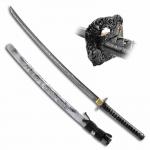
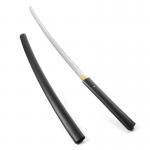
 (1)
(1)
